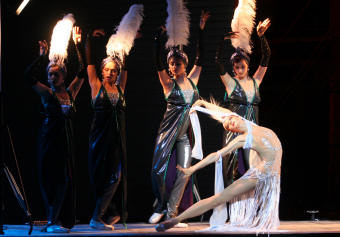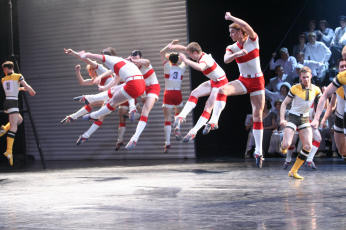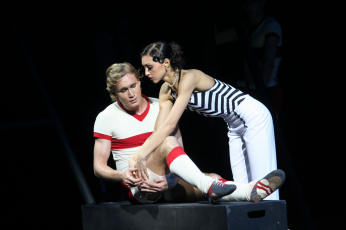|
Editorial Board
Melanie
Eskenazi
Webmaster: Len Mullenger
|
Seen and Heard Ballet Review
Shostakovich, The Golden Age: Mariinsky Theatre Ballet, Noah D Gelber (choreographer), Tugan Sokhiev (conductor) English National Opera, The Coliseum, London, 28.7.2006 (AO)
This production of Shostakovich’s ballet was premiered in on 28th June, so is brand new – straight from St Petersburg, where obviously, the Mariinsky audience see and hears far more of the company’s work than we do in London, and presumably have very high expectations. After the spectacular production of The Nose (see review) I was really looking forward to The Golden Age. It was an interesting evening, but very certainly very different indeed. Shostakovich was only twenty years old when he was offered the commission to write the piece. With his First Symphony, he had established a reputation for bringing together a combination of different musical styles to create something new and vibrant, expressing the vigour of the new Republic. The young composer was thus a natural choice for a ballet contrasting the capitalist west and the “purity” of Soviet youth. In private life, he was also a fanatical football fan. Obviously, the political background no longer matters. Nonetheless, the dichotomy plays an integral part in the ballet as a musical whole. Almost by definition, and certainly in this case, music written for ballet must adapt to the genre, allowing for numerous set pieces in which the dancers can do their thing. Ballet music therefore needs an underlying thrust to convince as a musical whole as well as to hold together the episodic nature of music designed to highlight dance. So the contrast between “western” dance music and the “pure” sturdy music written for the Soviet footballers creates an essential tension in the work, as music.
Moreover, Shostakovich had recently returned from a first visit abroad to Weimar, then one of the modern music and drama. He was fascinated by jazz, modern dance, agitprop cabaret, indeed the whole creative, chaotic buzz of 1920’s Germany – so very different from the repression in Soviet Russia. Alban Berg’s Wozzeck was sensationally popular. Shostakovich befriended Berg, learning from him what was to be an enduring influence on his own work. Weill’s Threepenny Opera, with its cabaret influenced “numbers”, following one after another, would have shown the potency of music written in an episodic style: substitute song for ballet, and there’s a connection. In writing this ballet, Shostakovich could indulge his new found musical discoveries, while ostensibly mocking them to please the Stalinist censors. He later transcribed passages for piano which could be enjoyed in relative privacy. That is perhaps why the music still rings true with a sense of enthusiastic commitment. A rapid succession of tableaux unfolds – a waltz, a polka, a tango, jerky, angular rhythms that evoke the spirit of social subversion that the “jazz age” represented, even in the decadent west. Shostakovich employs what were in 1920’s Russia, daring, “modern” instruments, like the xylophone, woodblocks, and something known as a “flexitone”. Official music critics at the time hated it, though audiences may have relished its freedom of expression. To our ears, it’s still a lively, irreverent romp that makes us remember just how revolutionary “modern” and popular music was in the 1920’s. In the enclosed acoustic of the Coliseum, a little volume goes a long way. For whatever reason, the orchestra played at a relentless pace, details being lost in the overall brashness. There wasn’t much sense of the inherent tension between different types of music, or of any poignancy reflecting the music’s origins. Instead, the recurring “Tea for Two” quotation seemed to be played for the easy laughs it got from the audience.
This staging could not possibly have happened in Soviet times. While the anti capitalist element may be played down, an altogether new element is added: a commentary on the Soviet Union itself. Perhaps the rows of refugees, the blinded prisoners marching in circles, and the mass execution, may refer to Germany, but they refer equally to Stalinist Russia. As my companion remarked, “If they’d tried this in the USSR, the cast would not have made it home that night”. It could have been a powerful statement, but the choreography wasn’t particularly inspired. There were lovely set pieces, such as the acrobats, their “oriental” costumes reflecting the vaguely pentatonic exoticism in the score. Nonetheless, with dancers of this calibre, one would have supposed they’d be perfectly capable of much more imaginative, challenging dancing. Even to a non football fan like me, there would seem to be more opportunities in this score to celebrate the balletic effects of physical sport. While the dancers executed what they had to do well, altogether this production was disappointing, though entertaining enough in its way. There’s so much more in this music and libretto that it was, sadly, a lost opportunity. The finale was staged entirely without dance.Instead, a huge icon of Shostakovich appeared while the final movement was played. Of course it was a tribute to the composer, though in this photo he looks incongruously like Harry Potter. Nonetheless, it reminded me uncomfortably of the huge portraits of Lenin and Stalin that used to dominate Party rallies.
Back to the Top Back to the Index Page |
| ||
|
||||





